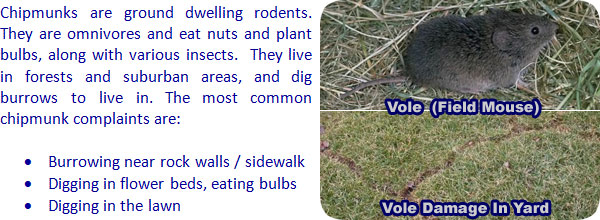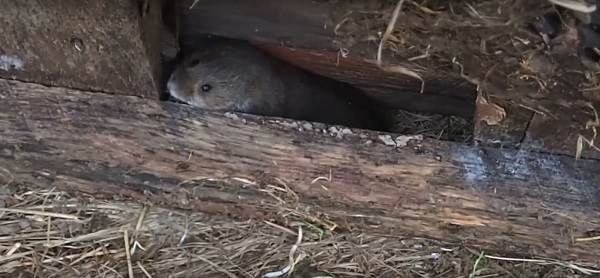 If you need vole help, click on my Nationwide List of Vole Removal Experts for a pro near you.
If you need vole help, click on my Nationwide List of Vole Removal Experts for a pro near you.
How to Kill a Vole
Voles live just about everywhere in the US and
Canada depending on the type of vole.
There are 23 vole species in the United
States.
The USDA Cooperative Extension Service has conducted
years of research on the vole populations across the
US and select border regions of southern Canada due
to the species’ economic impact on agricultural
production.

The seven most prevalent vole species damaging
alfalfa and apple crops are the:
·
Prairie vole
·
Mountain vole
·
Meadow vole
·
Long-tailed vole
·
Woodland vole
·
Oregon vole
·
California vole
Voles are commonly called field mice.
They have different types of camouflaging
marks and colors to their fur. Voles are very active
foragers and provide a ready source of food for many
different types of winged and land-based predators.
However, predators do little to control vole
populations due to vole breeding capacity and annual
breeding cycles.
Young females may begin breeding as young as
two weeks and can produce offspring one to five
times per year, usually during the spring and
summer.
Vole breeding capacity can be year round. Voles do
not hibernate.
Voles roam no further, on average, than a quarter
acre from their homes.
Vole population density and resulting food
requirements lead to significant crop damage during
the spring and summer months. Voles will store seeds
and tubers for winter feeding.
Bark and branch tips are a winter favorite.
Voles do not hibernate feeding year round on
preferred food sources available within their
habitat range.
Vole feeding habits can create severe growth
setbacks to fruit trees and early growth pasture
following winter thaws.
Recent extension research findings showed
there can be as many as 99 voles per acre of
full-grown alfalfa.
It is that scale of population density which
can lead to average losses of one million pounds of
alfalfa per year on a mid-sized dairy or cattle
farm.
Here are some preferred vole population control
techniques farmers to offset crop losses due to vole
infestations, from non-lethal to lethal in nature.
Collaring prevent voles from feeding in orchards on
young seedlings and saplings. Collars encircle the
slender trunks of the young orchard stock and set
three inches deep into soil around the trunk to
prevent voles from burrowing to nibble away at the
tender bark and young tissue just beneath it.
Orchards are generally too large to be fenced as a
protection against voles.
Traps can be set around the orchards at
strategic immigration sites to monitor vole traffic
before investment is made in collaring. Collaring
significantly reduces a source of year round food
for voles.
Habitat modification prevents voles from using the
surrounding environment to nest and reproduce.
Those neat and tidy farms seen from the
roadside are neat and tidy for a reason.
Voles love to nest in weedy waterways and
mulch beds around trees and fence rows.
Mowing and tillage keeps ground cover to a
minimum and forces voles to seek shelter farther
away from food sources making them easier prey to
hawks and other predators, disrupting their foraging
and food storage activities.
Zinc phosphide pellets are an effective vole poison
in pelleted form. However, pellets can poison birds
and waterfowl as well if broadcast indiscriminately.
Pellets placed in burrow openings can reduce
this risk to non-target animals.
Fumigants are effective in small dose application
into small scale burrows.
Once voles reach major population size (1700
voles per acre in some documented cases in
Washington State) fumigants become less effective as
burrows become deeper and more difficult to
penetrate and isolate for treatment.
Use of firearms has been found to be wholly
ineffective.
Predatory controls have not been shown to be
significantly effective on any scale against vole
infestation.
Cats, garden snakes, and predatory birds can
thin the population but not to the point of
reversing population growth enough to stem crop
losses.
Against a populous pest like the common field
mouse, farmers are better off preventing vole
infestation through the judicious, vigilant use of
non-lethal management techniques which are
consistent with best practices for home and
farmstead management.
Voles will advantage themselves based on the
environment that suits their nesting needs to
support their year round feeding requirements.
Disruption of their food foraging and storage
activities is the most prudent way to manage a
hungry vole population.